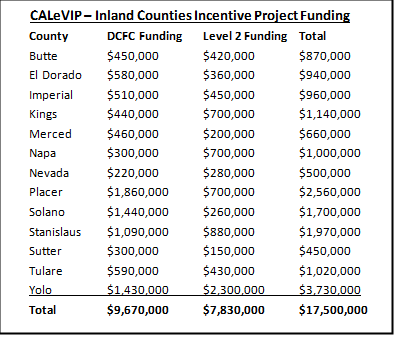For Immediate Release: May 17, 2021
Applications open May 18
SACRAMENTO – The California Energy Commission (CEC) announced today that $17.5 million is available to expand public electric vehicle (EV) charging in 13 rural counties. Incentives available through the new Inland Communities Incentive Project will cover up to 75 percent of EV charging equipment costs. More than a third of the funding is dedicated to installations in under-resourced communities.
Eligible counties include Butte, El Dorado, Imperial, Kings, Merced, Napa, Nevada, Placer, Solano, Stanislaus, Sutter, Tulare and Yolo.
The effort is one of 10 regional initiatives established under California Electric Vehicle Infrastructure Project (CALeVIP) which provides incentive funds for new charging stations at local businesses, shopping centers, gas stations, public facilities, multifamily housing and other community locations throughout the state.
CALeVIP is one of several initiatives aimed at advancing Governor Gavin Newsom’s executive order requiring sales of all new passenger vehicles to be zero-emission by 2035. Funding comes from the CEC’s Clean Transportation Program, which invests up to $100 million annually to support California communities, increase access to EV charging infrastructure, support innovation and accelerate the deployment of advanced transportation and fuel technologies.
“CALeVIP incentives are crucial to equitably expanding electric vehicle infrastructure to every corner of the state,” said CEC Commissioner Patty Monahan. “More ready access to charging means Californians can have confidence that EVs can meet their transportation needs, whether in urban or rural areas. Investments in infrastructure underpin EV adoption and help bring California’s vision of a zero emission transportation sector to fruition.”
A minimum of 35 percent of funding will be invested in disadvantaged or low-income communities in all counties, with a minimum of 25 percent reserved for installations in unincorporated communities in Placer, Solano, Stanislaus and Yolo counties.
Since December 2017, CALeVIP has issued more than $138.4 million for EV charging installations across 10regional incentive projects to support state goals to get 5 million electric vehicles on California roads by 2030 and to install 250,000 vehicle charging stations to service those vehicles.
Currently, the majority of California’s public EV charging stations are located in urban and suburban population centers, according to EV infrastructure experts at the Center for Sustainable Energy (CSE), administrators of CALeVIP.
“To achieve California’s ambitious EV adoption goals, we must incentivize and install charging stations in all areas of the state,” said Andy Hoskinson, CSE’s senior manager for EV infrastructure. “CALeVIP’s expansion of public charging makes sure our rural communities, which often have limited funding, are not left behind. Having these charging locations will help the areas increase consumer adoption of electric vehicles and reduce transportation emissions.”
Applicants for the Inland Communities Incentive Project can receive $3,500 to $6,000 per connector for a commercial-grade Level 2 EV charger and $30,000 to $80,000 for a high-powered DC fast charger. The higher amounts for both charger types are available for installations in disadvantaged or low-income communities and for Level 2 chargers at multifamily housing located anywhere in the participating counties.
Rebate funds can cover the purchase and installation of charging equipment, electrical infrastructure, utility costs, network agreements and other related costs.
Typical Level 2 chargers deliver 15 to 35 miles of electric driving range per hour of charging and are suited for locations where drivers are parked for a few hours. DC fast chargers can provide more than 150 miles of driving range per hour of charging, which is ideal for major destination areas and along travel corridors.
Property owners and managers interested in installing EV chargers can apply for funding online at the website CALeVIP.org. Applicants can qualify for multiple charger rebates at a location. The website CALeVIP Connects provides information on electric vehicle installers and service providers.
###
About the California Energy Commission
The California Energy Commission is leading the state to a 100 percent clean energy future. It has seven core responsibilities: developing renewable energy, transforming transportation, increasing energy efficiency, investing in energy innovation, advancing state energy policy, certifying thermal power plants, and preparing for energy emergencies.
About the Center for Sustainable Energy
One simple mission—DECARBONIZE. The Center for Sustainable Energy® (CSE) is a nonprofit that designs and manages state, local and utility-scale clean energy and transportation programs across the U.S. for governments, regulated entities and the private sector. Learn more at EnergyCenter.org.

